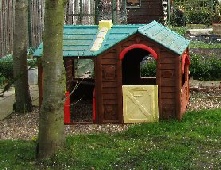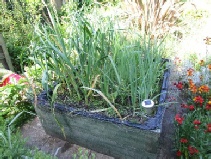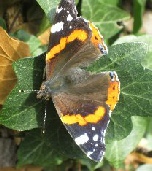





Gardening: Appreciating Change: 5) Family Changes & Wild Life
So we previously considered major weather changes and the seasons, changes through growth and even death of our plants, the ways of Nature, and then in the last article moved on to the way we ourselves interact with our gardens and the ways we may be influenced by TV programmes, Garden Centres and even Garden Shows. This final article might be summed up as the changes in life around us, first of all our families and then the many living creatures that deign to habit our garden.
In the earlier years of the children, the bottom quarter of the garden was allowed to run wild, partly to give them space to do what they liked there, and partly every November to have a place where we could have bonfires for Guy Fawkes night. Now there are some memories! When you have a large garden it means that every Autumn there is a lot to be got rid off and memories of sixteen foot high bonfires still linger. As they grew, had their own families and did their own things on Bonfire Nights, the need to make this provision died away. The bottom area has become respectable. In one period of our history, there was a path that wended its way round this overgrown and still slightly wild area with trees allowed to run riot, and so the dark path became known as ‘the jungle’ (said with nervous overtones), a slightly scary adventure for the next generation. But that is now gone; it is safe and respectable although we do still preserve an area for a chimera and fire-
5. Changes in the Family
It is perhaps something that can easily overlooked in a review of our past history but, for us at least, changes in family have without doubt played a significant part in the changes that have occurred in the garden. We moved into this present house when my wife was expecting our first child. Two more followed in the next four years. For the following, let’s say fifteen years, the garden in our minds was a place for play for the children. I have already referred to them playing in the old garage but of course a garden for children must have space and space probably means lawn. In the early years I think we had lots more lawn area than we have now. As they grew up and left home there was a period where lawn was an unnecessary requirement, just something demanding regular cutting. The arrival of grand children is different for they are not, in our case at least, around as much.
But as we grew older, like many other people, we started thinking, ‘how can we make this garden more maintenance free or at least easier to maintain?’ The answer has been more paved paths, more paved or graveled areas. Yet the balance is that retirement means more time available to give to the garden. Cutting tops out of dead trees has become an activity forbidden by ‘she-
Bees: Bumble bees or even the smaller worker bees need our encouragement. In fact if they die out (and there have been noises about us being on the edge of a crisis) then we will be seriously on the edge of a major food crisis, so we as gardeners can actively play our part in staving that off. Nectar and pollen are key things to be provided and they come with your flowers, and some are better providers than others. For us, lavender and wisteria are two favourites but there are many more.
But Bats? Having said that you can attract a variety of wildlife, there are times when all your efforts are to no avail. At one time we had bats flying around at dusk. We put up a bat-
Not so friendly: Over the years we have delighted in having hedgehogs snuffling through the leaves – until a badger arrived and we heard a terrified squealing. No more hedgehogs. We have tried battling with the badger(s) and have concluded that the best thing is to give these determined creatures an easy passage way through the garden. A friend says feed them peanuts but that seems to be going too far for a creature we don’t like. Our neighbour on one side, after a months-
Birds: Ok, I admit we have become really avid observers of the bird life that regularly habits our garden, sometimes briefly, sometimes for a season of more. Included in the list are robins, blackbirds, blue tits, great tits, long tailed tits, a green woodpecker, dunnocks, a thrush, gold finches, green finches, chaffinches, collared doves, pigeons, starlings, sparrows, wrens, and goldcrests. The activities of these provide sufficient fuel for another three pages, so I will content myself with one recent anecdote. Two robins have been particularly friendly, seeing my digging as a source of pickings. I am careful to step back and rest to give them space and they seem to appreciate that. I don’t know if they are the same robins but a similar process happened last year and had been going on for a number of weeks this year. A few weeks back (and this is true) I paused up from one bit of soil clearing and sat on a garden chair a few feet away. After a moment or two, one of the robins flew over, perched on my knee, looked me in the face for about twenty seconds, coking his head from one side to another while I spoke to him, and then flew off.
Constant Change
The sad thing about the wildlife is that it is constantly changing, hence its space here in this article. Last year we had a family of about seven long-
Well, if you have managed to stick with me through all these ramblings, well done! As I said at the beginning, the idea came after a request to do a talk and it seemed a waste not to anchor it a bit more in these pages. I hope you, like the lady I cited, have been provoked to consider your own experiences in your garden, perhaps appreciating them more, and perhaps being challenged to think those immortal words of the President in that past TV series, The West Wing, “What’s next?” Change is here to stay. Let’s enjoy it, run with it, help it along and, from time to time, sit in the summer shade and appreciate it.
Attracting Wildlife: In the RSPB book “Gardening for Wildlife”, author Adrian Thomas deals with a number of ‘myths’. Myth No. 5 is ‘You can attract wildlife to your garden’ to which he answers, “Oh come on, surely I’m joking,” and goes on to suggest that the skill is making your garden attractive for when creatures happen to be passing by, so they either stay or come back.
Butterflies: For us, becoming butterfly-


Water Attractions: I had already, many years back, coming across some bricks and a slab of marble, decided to build a ‘water feature’ which is an oblong 44x27 inches two feet high but with only nine inches deep water (it’s still there round by the greenhouse) which attracted a couple of frogs, but when one of my grand daughters on a visit told me about how her class had been ‘pond dipping’, I casually asked, “Oh, shall I build a proper pond here so you can do pond dipping when you come round?” A preformed liner made the first pond, probably about two foot by three foot, and before we knew it frogs and newts turned up in profusion, and that lasted several years. My enthusiastic wife, who is now our official pond spotter, slipped I think on the end with the result that eventually the bent liner leaked so another project had arrived. This time we used a sheet liner and the end result is a more formal looking pond with slabs around the edge about 8 x 5 feet and yes, the newts and the frogs are back. An almost compulsory question for visiting grandchildren by my wife is, “Do you want to see the newts? And we have a water boatman!” But it has been fun watching the life and the plants growing. It’s not only Monet who is now a fan of water lilies.
